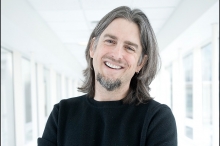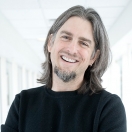

John Quackenbush is being honored as a Champion of Change for the vision he has demonstrated and for his commitment to open science.
In a June 2000 press conference, President Bill Clinton announced the initial survey of the entire human genome. In describing the extraordinary scientific and technical achievement, Clinton remarked, “Without a doubt, this is the most important, most wondrous map ever produced by humankind.”
Announced at the dawn of a new millennium, the completion of that first genome sequence sparked excitement worldwide and ignited the imaginations of both the scientific community and the general public. Upon unlocking of the genetic blueprint found in each of our cells, we now had a unique window, not only into the commonalities shared among all humans, but also into what makes each of us unique. Most importantly, decoding our genetic code created the opportunity for rapid advances in medical research that we hoped would lead to a promising era of personalized medicine. Yet for more than a decade, the prohibitive cost of genome sequencing challenged our progress.
But no longer. Thanks to new, advanced technologies, the cost of sequencing a genome has plummeted and is continuing to decrease rapidly. What once took years and cost billions of dollars can now be carried out in little more than a day, and for less than $3,000. However, one challenging question remains: How can we efficiently and effectively collect, manage, analyze, interpret, and share vast amounts of sequencing data — all six billion chemical “letters” gleaned from our genomes and the information they encode — in ways that make them usable, useful, and above all, private and secure?
The answer to this ultimate “Big Data” question has always been clear to my colleague Mick Corell and me. After years of work handling genomic data and developing analytical methods for discovering genomic factors that influence disease, we came to understand the limitations of existing technologies for meeting the unique challenges of this new genomic era. So in 2011 we launched GenoSpace, a company focused on developing innovative and accessible computational tools for making genomic data accessible. We have created a cloud-computing environment that enables complex genomic and clinical data to be securely stored, accessed, and analyzed, as well as tools that make information accessible to a broad range of users, including scientists, drug companies, health care organizations, physicians, and patients themselves, all of whom have different needs.
Our partnership with the Multiple Myeloma Research Foundation (MMRF) represents an important example of how our technology can help drive innovation. The MMRF’s CoMMpass study is an open-science project that unites competitors from the pharmaceutical and biotech industries, academic institutions, and community cancer centers through a publicly available, IP-free data ecosystem focused on finding a cure for this devastating disease. And we at GenoSpace are proud to have created the MMRF Researcher Gateway, featuring some of the most advanced and innovative data-analysis tools available, which is open to the world. We are also excited to have developed the MMRF Community Gateway, a new resource that will bring patients together to share information and become active partners in searching for a cure.
My colleagues and I at GenoSpace are honored to be recognized as a White House Open Science Champion of Change. Nearly every major scientific revolution has been driven by access to new sources of data and information. GenoSpace is proud to be a leader in driving the revolution in biomedical research and health care by creating tools that foster collaboration, spur medical research, and accelerate the pace of scientific progress — all the while recognizing the important role that each individual patient can play in the process of medical discovery.
John Quackenbush is a Professor of Biostatistics and Computational Biology at the Dana-Farber Cancer Institute and the Harvard School of Public Health. He is also CEO of GenoSpace, which he and Mick Correll co-founded in 2011.


